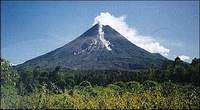Earthquake in Indonesia may trigger eruptions of three volcanoes
An earthquake that killed more than 70 people in western Indonesia may have led to heightened activity at three volcanoes, experts warned Friday, as thousands flocked to perform weekly prayers at mosques damaged by the temblor.

"We should see the quake as a test for all of us ... and redeem ourselves by doing good deeds," said Muhammad Thantawi, a preacher told worshippers gathered outside a destroyed mosque close to Solok city on Sumatra island's western coast.
"Always remember that no matter hard the test is, there are still harder tests ahead."
Tuesday's quake, which was followed by a powerful aftershock, flattened scores of homes and buckled roads on Sumatra island's western side.
As survivors, many living in tents outside shattered homes, complained food, shelter materials and drinking water was slow in reaching them, they were warned of a new potential threat.
Geologists said sensors on the slopes of three active volcanoes - Talang, Tandikat and Merapi - have detected above average activity since the 6.3 magnitude temblor, which was also lightly felt in Singapore and Malaysia.
"We usually need about a month to observe whether the earthquake could trigger an eruption," said Gede Suantika, an official from Indonesia's volcanology institute.
Residents living near the 2,800-meter (9,186-feet) Mount Talang - one of the country's most active mountains - were nervous. In 2005, a minor eruption forced the evacuation of more than 2,500 people.
"Every night I keep my eyes on the peak before I go to sleep," said Nur Hayati, adding that an official from the volcano's monitoring post had told her village to be alert.
Indonesia, the world's largest archipelago, is prone to seismic upheaval because of its location on the Pacific "Ring of Fire," an arc of volcanos and fault lines encircling the Pacific Basin.
Suantika said the quake's epicenter was located on a fault line that goes close to the three volcanoes on its way to the southern part of Sumatra, which like many of Indonesia's 17,000 islands is dotted with volcanoes.
Volcanic eruptions have followed earthquakes in the past, but there is disagreement among scientists over whether the two are linked, according to a posting on the U.S. Geological Survey Web site.
Some residents living near Mount Talang said they were running low on food because they had not returned to work in fields on its slopes, the AP says.
"We have not received any aid," said Nuriah, who like many Indonesians uses only one name. "Maybe the government forgot about us."
Food, water and instant noodles have arrived in cities, but assistance has been slow to reach victims in surrounding areas, said Ahmad Arsnal, an official at the provincial emergency relief agency.
Agencies have given conflicting death tolls, as is common in disasters here.
A presidential spokesman said Wednesday that 52 people died, revising the toll down from 70 reported on the day of the quake. But a day later, West Sumatra vice governor Marlis Rahman said 74 people had died.
Subscribe to Pravda.Ru Telegram channel, Facebook, RSS!




